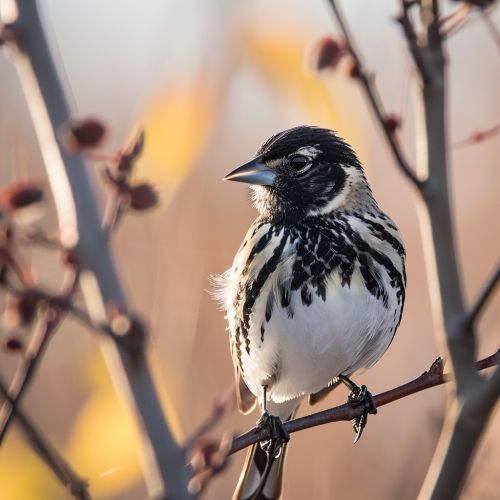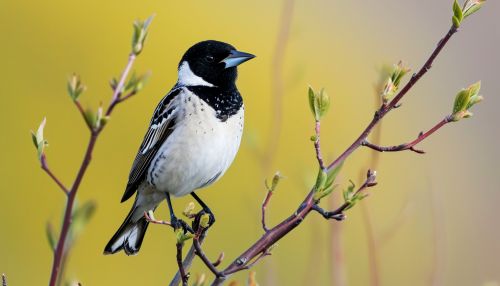Bobolink
Description and Taxonomy
The Bobolink (Dolichonyx oryzivorus) is a small New World blackbird and the only member of the genus Dolichonyx. It is a migratory bird, known for its long-distance travels from its breeding grounds in North America to its wintering areas in South America. The Bobolink is notable for its unique, bubbling song and its striking sexual dimorphism in plumage during the breeding season.


Physical Characteristics
Bobolinks are medium-sized songbirds, measuring about 16-18 cm in length and weighing between 30-40 grams. During the breeding season, males exhibit a unique reverse coloration, with a black belly and a white back, a feature that has earned them the nickname 'skunk bird'. They also have a buffy nape and a large, conical bill. Females and non-breeding males, on the other hand, have a more subdued coloration, with brown, streaked plumage that provides excellent camouflage in their grassland habitats.
Distribution and Habitat
Bobolinks are native to North America, where they breed in the northern United States and Canada, particularly in the prairie regions and other open grassland areas. They prefer habitats with tall grasses, including hayfields, wet meadows, and marshes. During migration, they can be found in a variety of habitats, including agricultural fields and rice paddies. In winter, they migrate to the southern parts of South America, including Argentina, Paraguay, and Bolivia, where they inhabit grasslands and cultivated areas.
Behavior and Ecology
Bobolinks are diurnal birds, active during the day. They are primarily ground feeders, foraging for seeds and insects in grasslands and agricultural fields. During the breeding season, males are highly territorial and will defend their territories with vigorous song displays and aggressive behavior towards intruders.
Bobolinks are monogamous, with pair bonds forming during the breeding season. Females build a cup-shaped nest on the ground, hidden in tall grass. They lay 3-7 eggs, which are incubated for about 12-14 days. Both parents feed the chicks, which fledge after about 10-14 days.
Conservation Status
The Bobolink is currently listed as a species of Least Concern by the IUCN. However, its population has been declining due to habitat loss, primarily from agricultural intensification and urban development. Conservation efforts are focused on preserving and managing suitable grassland habitats, as well as promoting bird-friendly agricultural practices.
